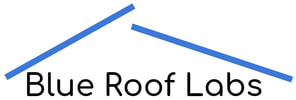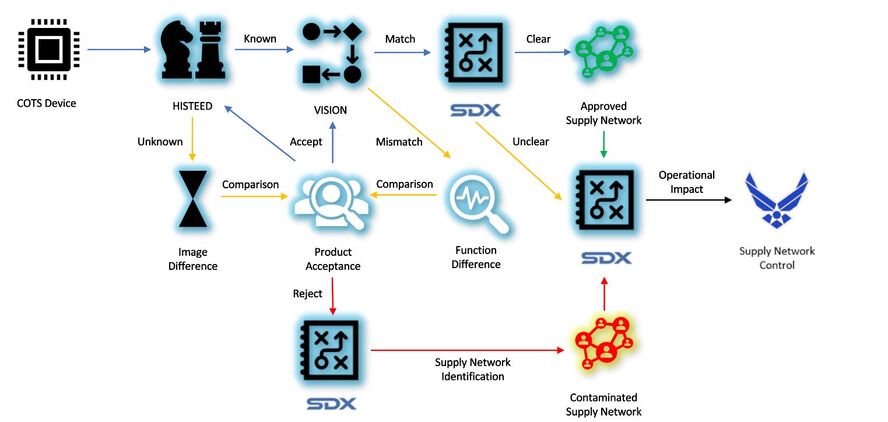What if we could trace the parts of any commercial off-the-shelf assembly (hardware or software) to prove provenance and suitability in military applications in a cost-effective manner?
We can determine the quality, integrity, and provenance of COTS (commercial off-the-shelf) assemblies and parts in a measurable and cost-effective way using our microelectronic analysis solution. This solution developed with our partners Supply Dynamics and Brunel University - London delivered exactly that to win the AFWERX Microelectronics Supply Chain Provenance Challenge over a field of more than 100 competing companies!
Our microelectronics project focuses on three main points.
Assembly Quality - Does it meet the specifications it was designed to meet?
Assembly Integrity - Does it fit the bill of materials of the designed assembly?
Provenance - Can electronics components / packaging / IP / etc. be traced back to their supplier / manufacturer / designer / etc.?
The graphic below outlines our proposed solution's process.
Assembly Quality - Does it meet the specifications it was designed to meet?
Assembly Integrity - Does it fit the bill of materials of the designed assembly?
Provenance - Can electronics components / packaging / IP / etc. be traced back to their supplier / manufacturer / designer / etc.?
The graphic below outlines our proposed solution's process.
HISTEED (High Speed Scanning For Detecting Tampered Electrical and Electronics Devices)
Multi-spectrum scanning, multi-faceted AI, multi-layered devices. HISTEED inspection determines whether assemblies meet both form and fit requirements.
VISION (Virtual Sensor Intelligent Network)
Based on proven technology, intelligent fail-over, solutions for soft vs. hard failures. VISION inspection determines whether software meets both fit and function requirements.
Assembly Quality
Assembly Integrity
Provenance
Multi-spectrum scanning, multi-faceted AI, multi-layered devices. HISTEED inspection determines whether assemblies meet both form and fit requirements.
VISION (Virtual Sensor Intelligent Network)
Based on proven technology, intelligent fail-over, solutions for soft vs. hard failures. VISION inspection determines whether software meets both fit and function requirements.
Assembly Quality
- HISTEED determines if the COTS assembly meets form and fit requirements.
- VISION determines if the COTS microcode meets integration and functional requirements.
Assembly Integrity
- HISTEED determines if the assembly is correct as presented - nothing missing or extra.
- VISION determines if the microcode meets both positive and negative mode operational requirements.
Provenance
- Items that pass both HISTEED and VISION inspections can then be associated with their custody chain records in several ways (ASN, EDI, blockchain, etc.) as preferred by the client.
Microelectronic systems can be broken down into two categories, hardware and firmware/software. Hardware refers to physical components, packaging, microchips, and other adjacent physical objects. Firmware and software refers to intellectual property blocks (or custom designs) that run on hardware.
Currently we can define hardware and firmware/software as either being in a 'Positive Mode' or a 'Negative Mode'.
Positive Mode
Negative Mode
Hardware - Positive Mode
Firmware/Software - Positive Mode
Hardware - Negative Mode
Firmware/Software - Negative Mode
Currently we can define hardware and firmware/software as either being in a 'Positive Mode' or a 'Negative Mode'.
Positive Mode
- System element does what it was designed to do per available documentation under nominal conditions.
- The behavior is predictable and consistent when operating with other nominal elements.
- The impact to other system elements when this element works correctly is predictable and consistent.
Negative Mode
- System element fails in a predictable and consistent manner as designed.
- The behavior is predictable and consistent when other elements fail around it.
- The impact to other system elements when this element fails is predictable and consistent.
Hardware - Positive Mode
- MIL-SPEC hardware is good but not cheap. Their testing processes are excellent.
- COTS hardware quality varies. Suppliers that follow industry standards (IEEE, ISO, SAE, etc.) are very good.
- Deficiencies in COTS hardware can often be made up for via intentional redundancy.
Firmware/Software - Positive Mode
- ISO and IEEE specifications for conventional development are OK, but slow and costly to develop. Long-term support is advantageous.
- Agile / XP / Scrum - based development is faster, but the code and applications scale poorly and provide little long-term support. Their lower up-front cost is advantageous.
- FDA requirements for medical devices come closest to being adequate, but they are rarely and inconsistently used.
Hardware - Negative Mode
- Failure Mode and Effects Analysis (FMEA) is common for mechanical and electromechanical elements.
- FMEA is rare and alternatives are generally lacking for microelectronics and power distribution components.
Firmware/Software - Negative Mode
- Failure Mode and Effects Analysis (FMEA) is nearly nonexistent and nearly impossible with increasing complexity.
- Ideally, we want to simulate everything in every possible combination. While software exists to do this, it is poorly configured and rarely used.
"For every action, there is an equal but opposite malfunction." - Dr. James Gantt
Our current industry is not well-equipped to handle system elements in their negative modes. Our microelectronics project aims to fill in the gaps and improve system elements in both their positive and negative modes.
Within the network control of the VSN (virtual sensor network), we keep a data structure called an interference matrix. The matrix records which failover models are appropriate in specific situations. Once a sensor failure is confirmed, we then engage the appropriate failover model. While a failover model is engaged, we prevent any other models that need that physical input from running, which eliminates the propagation of errors.
Using our system, the rest of a VSN can continue operating as normal. Even if an inhibited model is needed at a later point, we can utilize conventional error handling as situations require.
Using our system, the rest of a VSN can continue operating as normal. Even if an inhibited model is needed at a later point, we can utilize conventional error handling as situations require.
"You cannot inspect quality into a product" - Harold F. Dodge
Though we cannot inspect our way out of issues, we can adapt to them and prevent further issues. There are too many dimensions that are changing too quickly with too little control over them to successfully conquer the problems we encounter for more than an instant.
Technologies like VSN enable intelligent failover and reduce the effects of COTS hardware and software issues. That has, and continues to, work well in industrial applications. It is possible, it can be done!
Technologies like VSN enable intelligent failover and reduce the effects of COTS hardware and software issues. That has, and continues to, work well in industrial applications. It is possible, it can be done!
Our microelectronics project focuses on three main points.
Assembly Quality - Does it meet the specifications it was designed to meet?
Assembly Integrity - Does it fit the bill of materials of the designed assembly?
Provenance - Can electronics components / packaging / IP / etc. be traced back to their supplier / manufacturer / designer / etc.?
The graphic below outlines our proposed solution's process.
Assembly Quality - Does it meet the specifications it was designed to meet?
Assembly Integrity - Does it fit the bill of materials of the designed assembly?
Provenance - Can electronics components / packaging / IP / etc. be traced back to their supplier / manufacturer / designer / etc.?
The graphic below outlines our proposed solution's process.
HISTEED (High Speed Scanning For Detecting Tampered Electrical and Electronics Devices)
Multi-spectrum scanning, multi-faceted AI, multi-layered devices. HISTEED inspection determines whether assemblies meet both form and fit requirements.
VISION (Virtual Sensor Intelligent Network)
Based on proven technology, intelligent fail-over, solutions for soft vs. hard failures. VISION inspection determines whether software meets both fit and function requirements.
Assembly Quality
Assembly Integrity
Provenance
Multi-spectrum scanning, multi-faceted AI, multi-layered devices. HISTEED inspection determines whether assemblies meet both form and fit requirements.
VISION (Virtual Sensor Intelligent Network)
Based on proven technology, intelligent fail-over, solutions for soft vs. hard failures. VISION inspection determines whether software meets both fit and function requirements.
Assembly Quality
- HISTEED determines if the COTS assembly meets form and fit requirements.
- VISION determines if the COTS microcode meets integration and functional requirements.
Assembly Integrity
- HISTEED determines if the assembly is correct as presented - nothing missing or extra.
- VISION determines if the microcode meets both positive and negative mode operational requirements.
Provenance
- Items that pass both HISTEED and VISION inspections can then be associated with their custody chain records in several ways (ASN, EDI, blockchain, etc.) as preferred by the client.
Microelectronic systems can be broken down into two categories, hardware and firmware/software. Hardware refers to physical components, packaging, microchips, and other adjacent physical objects. Firmware and software refers to intellectual property blocks (or custom designs) that run on hardware.
Currently we can define hardware and firmware/software as either being in a 'Positive Mode' or a 'Negative Mode'.
Positive Mode
Negative Mode
Hardware - Positive Mode
Firmware/Software - Positive Mode
Hardware - Negative Mode
Firmware/Software - Negative Mode
Currently we can define hardware and firmware/software as either being in a 'Positive Mode' or a 'Negative Mode'.
Positive Mode
- System element does what it was designed to do per available documentation under nominal conditions.
- The behavior is predictable and consistent when operating with other nominal elements.
- The impact to other system elements when this element works correctly is predictable and consistent.
Negative Mode
- System element fails in a predictable and consistent manner as designed.
- The behavior is predictable and consistent when other elements fail around it.
- The impact to other system elements when this element fails is predictable and consistent.
Hardware - Positive Mode
- MIL-SPEC hardware is good but not cheap. Their testing processes are excellent.
- COTS hardware quality varies. Suppliers that follow industry standards (IEEE, ISO, SAE, etc.) are very good.
- Deficiencies in COTS hardware can often be made up for via intentional redundancy.
Firmware/Software - Positive Mode
- ISO and IEEE specifications for conventional development are OK, but slow and costly to develop. Long-term support is advantageous.
- Agile / XP / Scrum - based development is faster, but the code and applications scale poorly and provide little long-term support. Their lower up-front cost is advantageous.
- FDA requirements for medical devices come closest to being adequate, but they are rarely and inconsistently used.
Hardware - Negative Mode
- Failure Mode and Effects Analysis (FMEA) is common for mechanical and electromechanical elements.
- FMEA is rare and alternatives are generally lacking for microelectronics and power distribution components.
Firmware/Software - Negative Mode
- Failure Mode and Effects Analysis (FMEA) is nearly nonexistent and nearly impossible with increasing complexity.
- Ideally, we want to simulate everything in every possible combination. While software exists to do this, it is poorly configured and rarely used.
"For every action, there is an equal but opposite malfunction." - Dr. James Gantt
Our current industry is not well-equipped to handle system elements in their negative modes. Our microelectronics project aims to fill in the gaps and improve system elements in both their positive and negative modes.
Within the network control of the VSN (virtual sensor network), we keep a data structure called an interference matrix. The matrix records which failover models are appropriate in specific situations. Once a sensor failure is confirmed, we then engage the appropriate failover model. While a failover model is engaged, we prevent any other models that need that physical input from running, which eliminates the propagation of errors.
Using our system, the rest of a VSN can continue operating as normal. Even if an inhibited model is needed at a later point, we can utilize conventional error handling as situations require.
Using our system, the rest of a VSN can continue operating as normal. Even if an inhibited model is needed at a later point, we can utilize conventional error handling as situations require.
"You cannot inspect quality into a product" - Harold F. Dodge
Though we cannot inspect our way out of issues, we can adapt to them and prevent further issues. There are too many dimensions that are changing too quickly with too little control over them to successfully conquer the problems we encounter for more than an instant.
Technologies like VSN enable intelligent failover and reduce the effects of COTS hardware and software issues. That has, and continues to, work well in industrial applications. It is possible, it can be done!
Technologies like VSN enable intelligent failover and reduce the effects of COTS hardware and software issues. That has, and continues to, work well in industrial applications. It is possible, it can be done!












